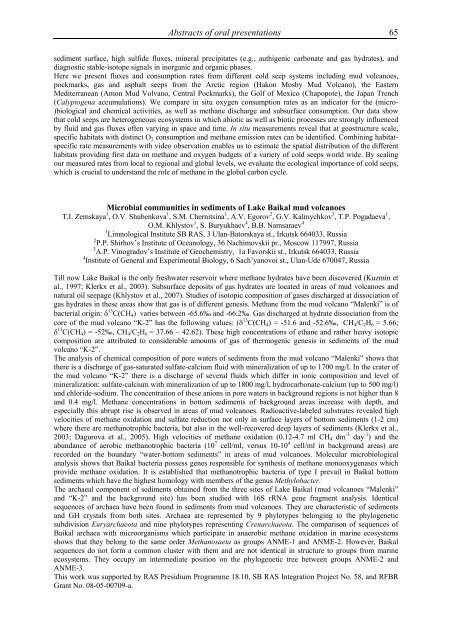Ninth international conference on - Marum
Ninth international conference on - Marum
Ninth international conference on - Marum
You also want an ePaper? Increase the reach of your titles
YUMPU automatically turns print PDFs into web optimized ePapers that Google loves.
Abstracts of oral presentati<strong>on</strong>s 65<br />
sediment surface, high sulfide fluxes, mineral precipitates (e.g., authigenic carb<strong>on</strong>ate and gas hydrates), and<br />
diagnostic stable-isotope signals in inorganic and organic phases.<br />
Here we present fluxes and c<strong>on</strong>sumpti<strong>on</strong> rates from different cold seep systems including mud volcanoes,<br />
pockmarks, gas and asphalt seeps from the Arctic regi<strong>on</strong> (Hak<strong>on</strong> Mosby Mud Volcano), the Eastern<br />
Mediterranean (Am<strong>on</strong> Mud Volvano, Central Pockmarks), the Golf of Mexico (Chapopote), the Japan Trench<br />
(Calyptogena accumulati<strong>on</strong>s). We compare in situ oxygen c<strong>on</strong>sumpti<strong>on</strong> rates as an indicator for the (micro-<br />
)biological and chemical activities, as well as methane discharge and subsurface c<strong>on</strong>sumpti<strong>on</strong>. Our data show<br />
that cold seeps are heterogeneous ecosystems in which abiotic as well as biotic processes are str<strong>on</strong>gly influenced<br />
by fluid and gas fluxes often varying in space and time. In situ measurements reveal that at geostructure scale,<br />
specific habitats with distinct O2 c<strong>on</strong>sumpti<strong>on</strong> and methane emissi<strong>on</strong> rates can be identified. Combining habitatspecific<br />
rate measurements with video observati<strong>on</strong> enables us to estimate the spatial distributi<strong>on</strong> of the different<br />
habitats providing first data <strong>on</strong> methane and oxygen budgets of a variety of cold seeps world wide. By scaling<br />
our measured rates from local to regi<strong>on</strong>al and global levels, we evaluate the ecological importance of cold seeps,<br />
which is crucial to understand the role of methane in the global carb<strong>on</strong> cycle.<br />
Microbial communities in sediments of Lake Baikal mud volcanoes<br />
T.I. Zemskaya 1 , O.V. Shubenkova 1 , S.M. Chernitsina 1 , A.V. Egorov 2 , G.V. Kalmychkov 3 , T.P. Pogadaeva 1 ,<br />
O.M. Khlystov 1 , S. Buryukhaev 4 , B.B. Namsaraev 4<br />
1 Limnological Institute SB RAS, 3 Ulan-Batorskaya st., Irkutsk 664033, Russia<br />
2 P.P. Shirhov’s Institute of Oceanology, 36 Nachimovskii pr., Moscow 117997, Russia<br />
3 A.P. Vinogradov’s Institute of Geochemistry, 1а Favorskii st., Irkutsk 664033, Russia<br />
4 Institute of General and Experimental Biology, 6 Sach’yanovoi st., Ulan-Ude 670047, Russia<br />
Till now Lake Baikal is the <strong>on</strong>ly freshwater reservoir where methane hydrates have been discovered (Kuzmin et<br />
al., 1997; Klerkx et al., 2003). Subsurface deposits of gas hydrates are located in areas of mud volcanoes and<br />
natural oil seepage (Khlystov et al., 2007). Studies of isotopic compositi<strong>on</strong> of gases discharged at dissociati<strong>on</strong> of<br />
gas hydrates in these areas show that gas is of different genesis. Methane from the mud volcano “Malenki” is of<br />
bacterial origin: δ 13 С(CH4) varies between -65.6‰ and -66.2‰. Gas discharged at hydrate dissociati<strong>on</strong> from the<br />
core of the mud volcano “K-2” has the following values: (δ 13 С(CH4) = -51.6 and -52.6‰, СН4/С2Н6 = 5.66;<br />
δ 13 С(CH4) = -52‰, СН4/С2Н6 = 37.66 – 42.62). These high c<strong>on</strong>centrati<strong>on</strong>s of ethane and rather heavy isotopic<br />
compositi<strong>on</strong> are attributed to c<strong>on</strong>siderable amounts of gas of thermogenic genesis in sediments of the mud<br />
volcano “K-2”.<br />
The analysis of chemical compositi<strong>on</strong> of pore waters of sediments from the mud volcano “Malenki” shows that<br />
there is a discharge of gas-saturated sulfate-calcium fluid with mineralizati<strong>on</strong> of up to 1700 mg/l. In the crater of<br />
the mud volcano “K-2” there is a discharge of several fluids which differ in i<strong>on</strong>ic compositi<strong>on</strong> and level of<br />
mineralizati<strong>on</strong>: sulfate-calcium with mineralizati<strong>on</strong> of up to 1800 mg/l, hydrocarb<strong>on</strong>ate-calcium (up to 500 mg/l)<br />
and chloride-sodium. The c<strong>on</strong>centrati<strong>on</strong> of these ani<strong>on</strong>s in pore waters in background regi<strong>on</strong>s is not higher than 8<br />
and 0.4 mg/l. Methane c<strong>on</strong>centrati<strong>on</strong>s in bottom sediments of background areas increase with depth, and<br />
especially this abrupt rise is observed in areas of mud volcanoes. Radioactive-labeled substrates revealed high<br />
velocities of methane oxidati<strong>on</strong> and sulfate reducti<strong>on</strong> not <strong>on</strong>ly in surface layers of bottom sediments (1-2 cm)<br />
where there are methanotrophic bacteria, but also in the well-recovered deep layers of sediments (Klerkx et al.,<br />
2003; Dagurova et al., 2005). High velocities of methane oxidati<strong>on</strong> (0.12-4.7 ml СН4 dm -3 day -1 ) and the<br />
abundance of aerobic methanotrophic bacteria (10 7 cell/ml, versus 10-10 4 cell/ml in background areas) are<br />
recorded <strong>on</strong> the boundary “water-bottom sediments” in areas of mud volcanoes. Molecular microbiological<br />
analysis shows that Baikal bacteria possess genes resp<strong>on</strong>sible for synthesis of methane m<strong>on</strong>ooxygenases which<br />
provide methane oxidati<strong>on</strong>. It is established that methanotrophic bacteria of type I prevail in Baikal bottom<br />
sediments which have the highest homology with members of the genus Methylobacter.<br />
The archaeal comp<strong>on</strong>ent of sediments obtained from the three sites of Lake Baikal (mud volcanoes “Malenki”<br />
and “K-2” and the background site) has been studied with 16S rRNA gene fragment analysis. Identical<br />
sequences of archaea have been found in sediments from mud volcanoes. They are characteristic of sediments<br />
and GH crystals from both sites. Archaea are represented by 9 phylotypes bel<strong>on</strong>ging to the phylogenetic<br />
subdivisi<strong>on</strong> Euryarchaeota and nine phylotypes representing Crenarchaeota. The comparis<strong>on</strong> of sequences of<br />
Baikal archaea with microorganisms which participate in anaerobic methane oxidati<strong>on</strong> in marine ecosystems<br />
shows that they bel<strong>on</strong>g to the same order Methanosaeta as groups ANME-1 and ANME-2. However, Baikal<br />
sequences do not form a comm<strong>on</strong> cluster with them and are not identical in structure to groups from marine<br />
ecosystems. They occupy an intermediate positi<strong>on</strong> <strong>on</strong> the phylogenetic tree between groups ANME-2 and<br />
ANME-3.<br />
This work was supported by RAS Presidium Programme 18.10, SB RAS Integrati<strong>on</strong> Project No. 58, and RFBR<br />
Grant No. 08-05-00709-a.














